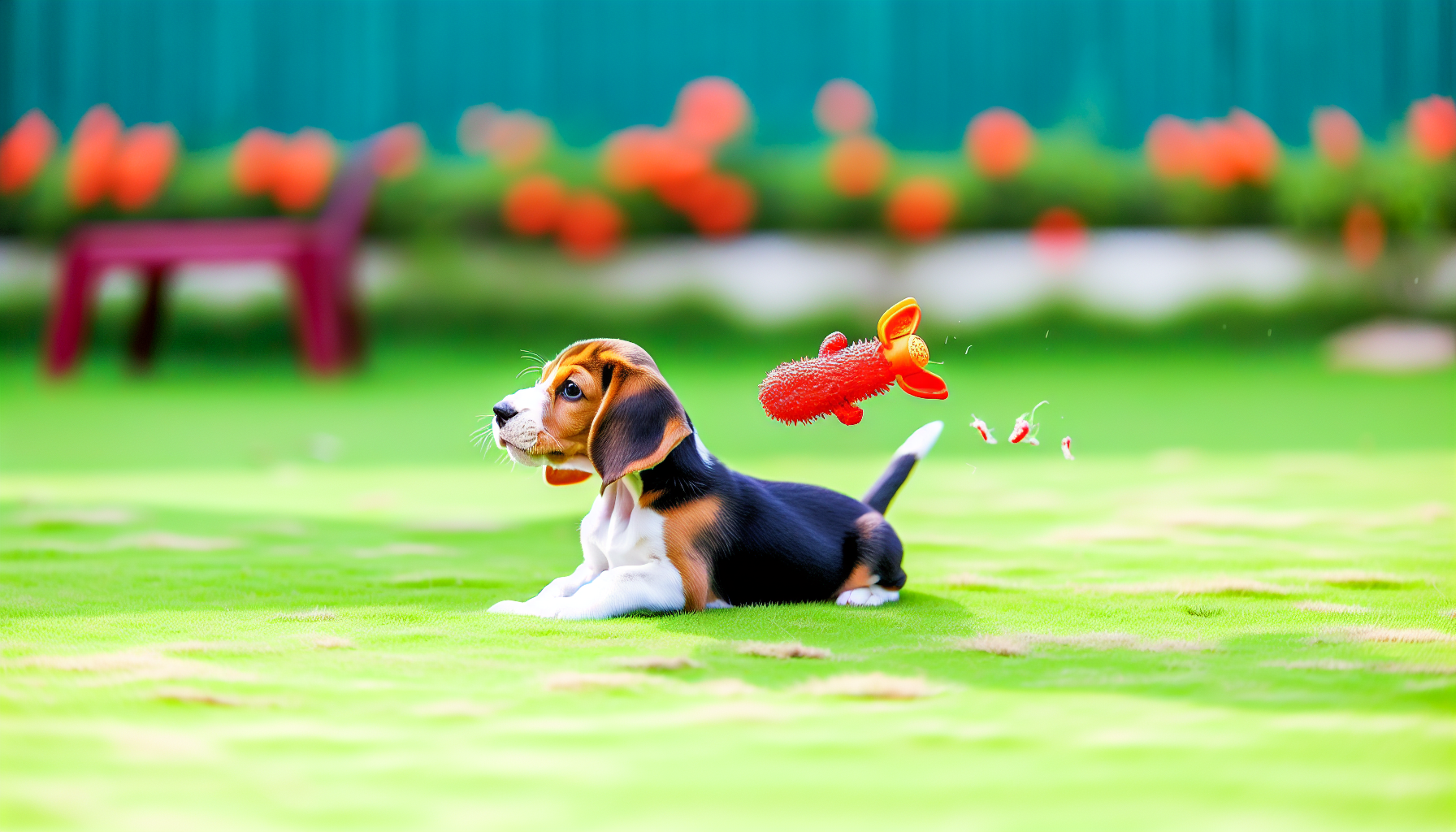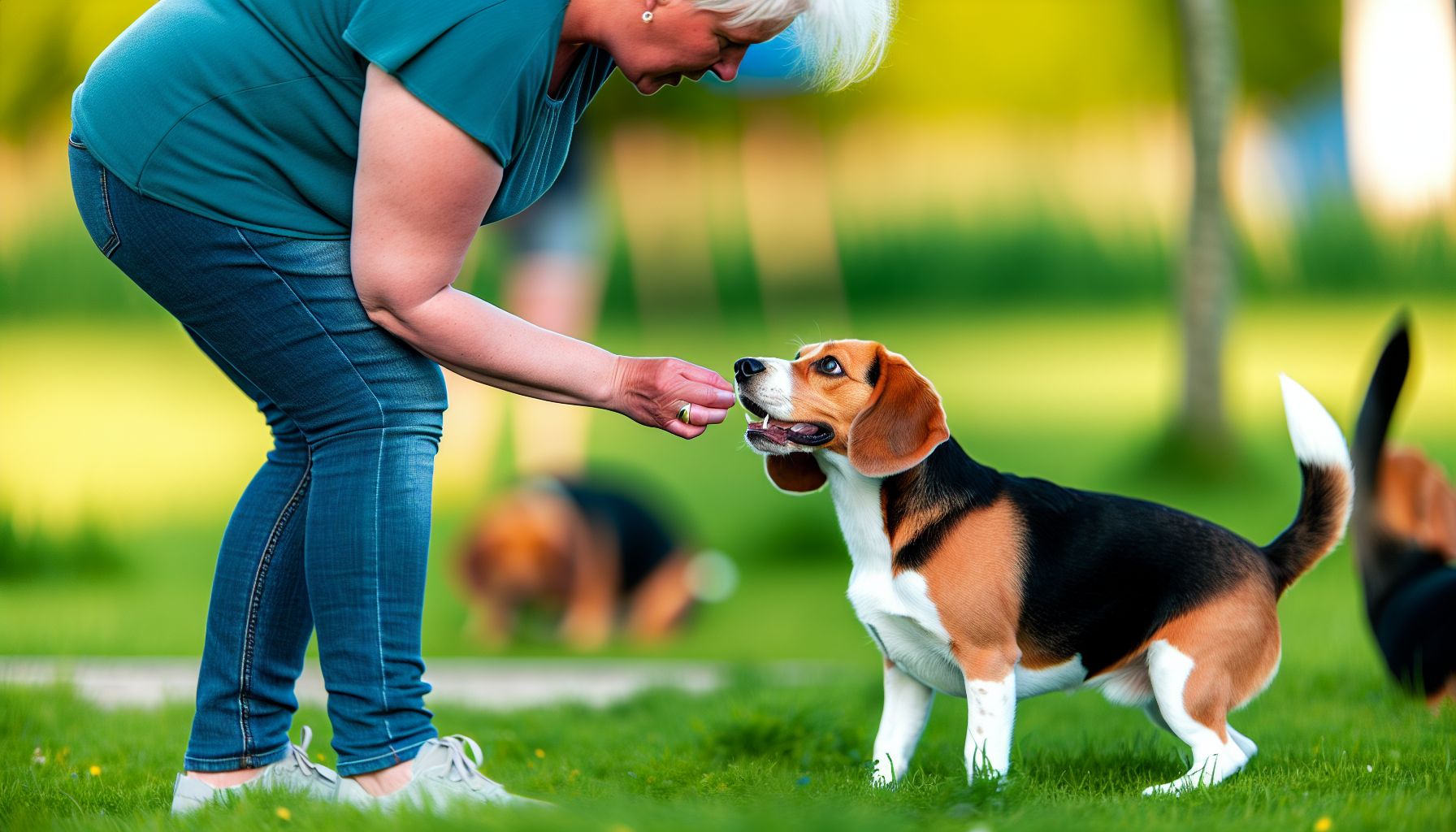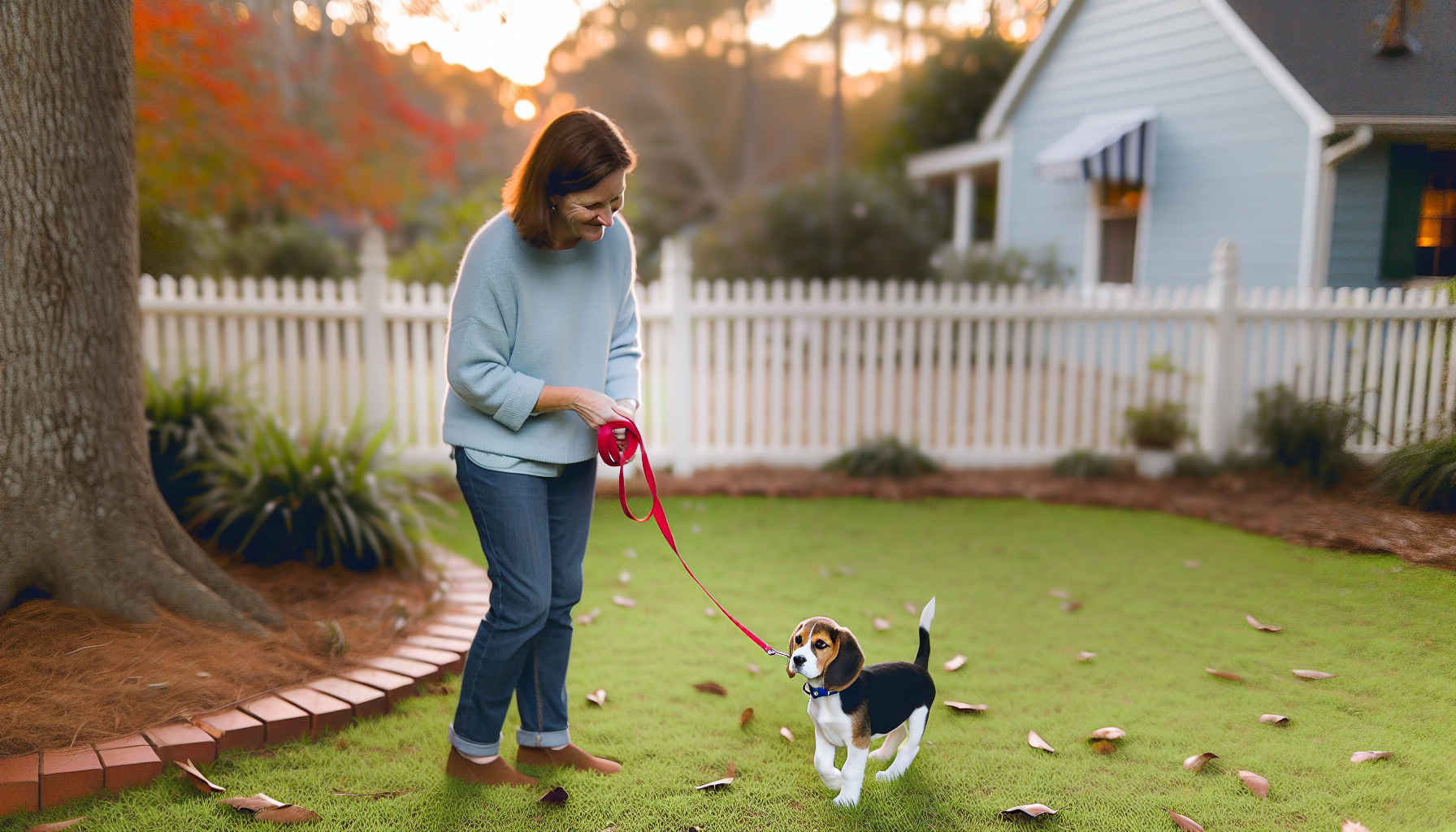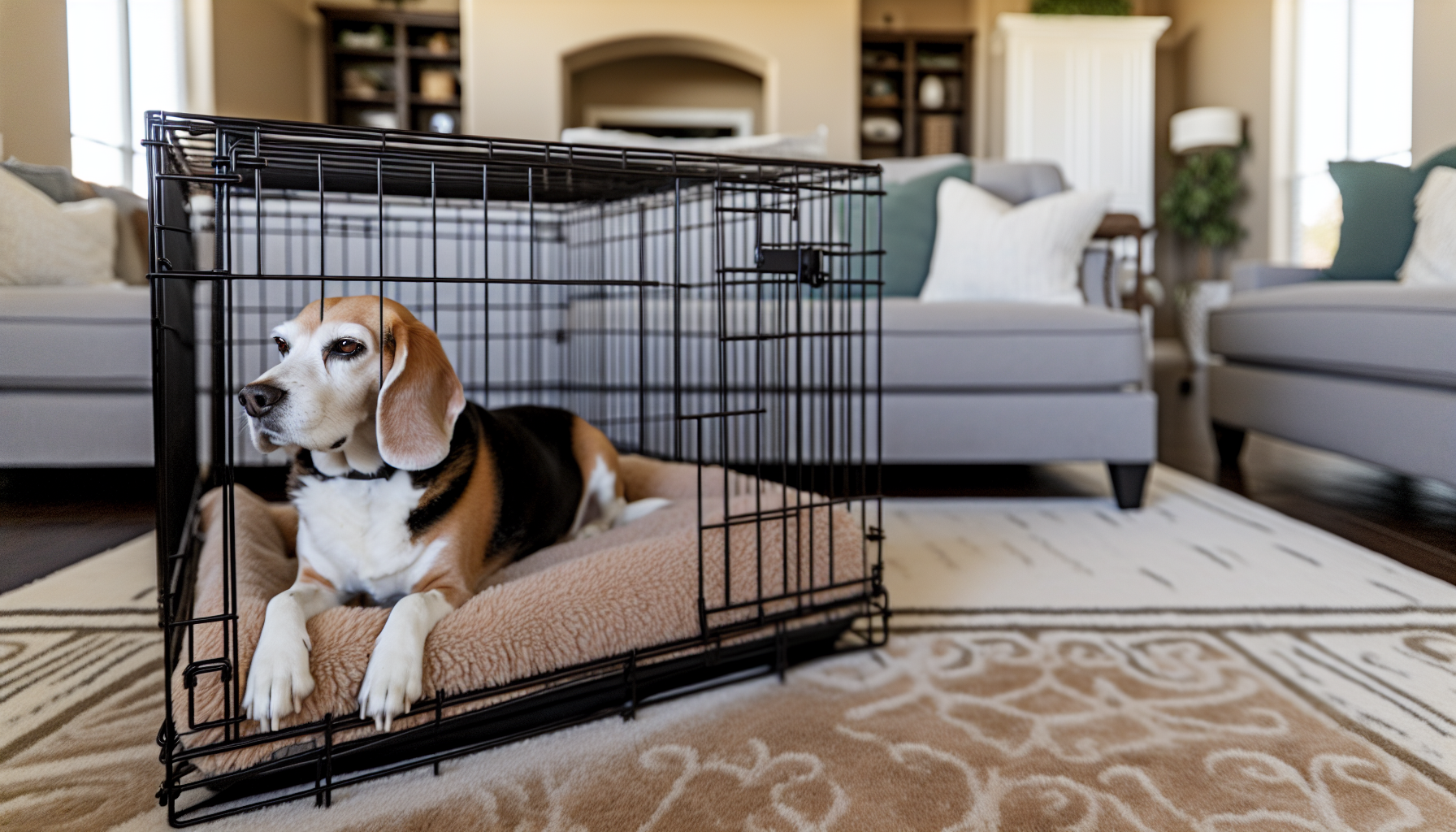Did you know that beagles rank as the 8th most popular dog breed in the United States? Their popularity, however, doesn't necessarily translate to ease of training. These charming dogs, with their acute sense of smell and independent nature, can indeed present a unique set of training challenges. Despite this, with a customized approach and a dose of patience, training your beagle can become a deeply rewarding experience for both of you.
Use this guide to unlock the secrets of effective beagle training, brimming with practical tips that harmonize the free spirit of your beagle with the essentials of disciplined training.
Key Takeaways
- Beagles can be challenging to train due to their natural instincts such as strong sense of smell and independence, but with patience, consistency, and use of positive reinforcement, they can be effectively trained.
- Establishing a routine, including regular exercise, mental stimulation, and using rewards judiciously during training sessions, is key to successfully training Beagles and managing their high energy levels.
- While Beagles are prone to distractions and may require more effort to socialize and train in basic commands, professional training resources and tools such as clickers, crates, and padded harnesses can be valuable aids in the training process.
Find out how to train your beagle to be the well-behaved pup you desire – Read Free Report
Demystifying Beagle Trainability

Image created with AI
First things first, let’s address the elephant in the room – Are beagles easy to train? The answer isn’t as straightforward as you might think. Beagles are indeed considered challenging to train due to their:
- Hunting instincts
- Strong sense of smell
- High energy levels
- Natural independence
These traits can lead to stubbornness and a tendency to follow their nose over commands, making them one of the more challenging dog breeds to train. But does that mean beagle training is a lost cause? Absolutely not!
Effective training of energetic dogs like beagles involves:
- Use of positive reinforcement through training treats
- Consistent enforcement techniques paired with patience
- Abundant praises to keep the dog motivated and encouraged through the process
Patience plays a crucial role as beagles, with their independent nature, may require more time to obey commands. Consistency, on the other hand, is important in establishing expected behaviors.
Understanding a beagle’s inherent traits, such as their scent-driven behavior, can improve training by customizing methods to their natural instincts. This results in a stronger bond between the owner and beagle, and facilitates a clearer communication pathway during training. So, while beagles may not be the easiest breed to train, with the right approach and a healthy dose of patience and consistency, you can certainly train your beagle to be a well-behaved pet.
The Beagle Owner's Success Blueprint
If you’re a new beagle owner, you might be feeling a bit overwhelmed. After all, where should you start with beagle training? Luckily, there are plenty of resources out there to help guide you. The Beagle Handbook by Dan Rice, Beagle Training Basics by Karen Douglas Kane, and Beagles for Dummies by Susan McCullough are just a few examples of the wealth of information that’s available at your fingertips. These resources offer comprehensive strategies for structuring a training plan, including house training, and encompass the fundamentals of beagle behavior, practical step-by-step training exercises, and insights into customizing your approach based on your individual dog’s personality.
Activities such as performance events, playtime, and special training exercises are vital in fostering a strong bond between beagle owners and their pets. This bond is fundamental for effective training as it cultivates trust and facilitates your beagle’s receptiveness to your guidance. The recommended approach is to allocate specific time for play and exploration, which can be used as a form of positive reinforcement for obedience training.
Furthermore, to cater to the energetic nature of intelligent dogs like beagles, it’s beneficial to schedule regular participation in dog sports or training activities for physical and mental stimulation.
1 – Harnessing the Beagle's Energy: A Training Advantage
How well you manage your beagle’s energy levels is a key factor that can significantly impact your beagle training. Beagles, being energetic dogs, need regular exercise not only for their physical well-being but also for managing their energy levels and preventing boredom. Without regular exercise, beagles can quickly become bored and destructive, making training a challenge.
It is advisable for beagles to have an exercise regimen of 1 hour twice a day. This level of exercise helps tire them out, which in turn is beneficial for enhancing their attentiveness and receptiveness during training sessions. It’s a simple yet effective strategy – a tired beagle is a well-behaved beagle. Adequate exercise can decrease a beagle’s high energy levels, thereby diminishing their inclination towards boredom and distraction, ultimately aiding in making beagles easier to train.
Not only does regular exercise help beagles respond better to training by expending excess energy, but it also leads to improved focus and attentiveness during training sessions, thereby enhancing their ability to learn from their owner.
2 – Cultivating Obedience: Positive Reinforcement Techniques

Image created with AI
In the realm of beagle training, positive reinforcement is an invaluable tool. Reward-based training techniques involve the use of treats, verbal praise, or clicker training. These methods are used to reinforce good behavior in animals. The idea is simple – when your beagle does something good, they get a reward. This encourages them to repeat the behavior in the future.
Food is considered a powerful motivator for beagles during training due to their positive response to treats. However, it’s important to be cautious of the potential risk of them developing an obsession with food, which could result in overeating and weight problems if not closely monitored. But don’t worry, this doesn’t mean you have to stop using treats altogether. Instead, consider using healthy treats in moderation, and always balance them with other forms of positive reinforcement.
For instance, verbal praise serves to strengthen positive behavior in beagles, fostering a sense of compliance and attentiveness during training sessions. Consistency is essential to ensure that beagles comprehend the expectations placed upon them. Recommended positive reinforcement strategies encompass reward-based training, utilizing treats and praise to promote desired behaviors, as well as employing gentle play and redirection techniques when teaching bite inhibition.
Establishing a Routine: Key to Potty Training Success

Image created with AI
For new beagle owners, potty training often poses one of the first significant challenges. It might seem like a daunting task, especially if you’re a first-time dog owner, but don’t worry. By establishing a consistent routine and using positive reinforcement, you can set your beagle puppy up for potty training success.
The essential factors for successful potty training of a beagle puppy include:
- Establishing a consistent routine, which involves taking them out frequently, such as every hour, to potty train effectively
- Being patient and attentive to their needs
- Praising and immediately rewarding your beagle puppy after they have finished toileting outside, as part of positive reinforcement
In the event of a beagle puppy having an accident indoors, it is advisable for the owner to meticulously clean up the area using an enzymatic cleaner to eradicate odors and deter the puppy from re-soiling the same spot. It’s also recommended to refrain from feeding or giving water to a beagle puppy three to four hours before bedtime in order to prevent nighttime accidents.
3 – Socialization Skills: Integrating Your Beagle With Other Dogs
A critical aspect of your beagle’s development is their socialization with other dogs and people. It helps them acclimate to various stimuli, such as:
- people
- sounds
- shapes
- sights
This ultimately contributes to their development as well-adjusted and sociable dogs.
Structured programs such as the AKC S.T.A.R. Puppy program can be advantageous for socializing beagle puppies as they provide a supervised environment for the puppies to learn manners and social skills alongside other dogs. Additionally, effective techniques for socializing Beagles with other dogs include:
- Using treats, praises, and toys to reinforce calm behavior
- Organizing controlled playdates with well-socialized dogs
- Implementing reward-based training to encourage positive interactions
These techniques can help ensure that your Beagle develops good social skills and is comfortable around other dogs.
4 – Mastering Basic Commands: From ‘Sit' to ‘Stay'

Image created with AI
The mastery of basic commands is integral to beagle training. From ‘sit’ to ‘stay’, these commands form the foundation of good behavior and obedience. The initial training goals for a beagle puppy include teaching basic commands and boundaries.
Employing clear and concise cues, such as ‘sit,’ along with positive reinforcements like treats or praise, and utilizing tools such as a clicker to mark the behavior, are effective techniques for teaching a beagle to sit. As for recall training, it’s recommended to initiate it in a confined space or utilize an extended leash to restrict their movement. Offering generous rewards and implementing positive reinforcement techniques can effectively enhance their receptiveness to the ‘come’ command.
5 – The Leash Connection: Training Beagle Puppies to Walk Politely
Like any other dog, beagles too must master the essential skill of walking politely on a leash. Introducing a collar or harness is the first step in leash training a beagle puppy. This will help them get comfortable with wearing it before beginning leash training. This might seem like a simple step, but it’s an important one. Your beagle needs to feel comfortable with their leash and harness before you can expect them to walk politely on it.
Leash training a beagle puppy can present challenges due to their strong olfactory senses and inclination to follow scents. Here are some tips to help you with leash training:
- When the puppy pulls or veers off course while on a leash, cease walking and wait for them to return to your side.
- Make sure to prevent the puppy from pulling or leading you in a different direction.
- This will help establish good leash manners and teach the puppy to follow your lead.
When it comes to establishing boundaries and teaching a beagle puppy to walk on a leash, consistency is key. Utilize the following methods to promote the puppy walking beside you:
- Use treats as positive reinforcement
- Reward the puppy when they walk politely on a leash
- Make sure the puppy associates walking on a leash with positive experiences
By using these methods, your beagle will be more likely to repeat the behavior in the future.
6 – Overcoming Distractions: Keeping Your Energetic Dogs Focused
The propensity of beagles to be distracted by scents often poses a challenge to keep their focus during training sessions. But don’t worry, there are strategies you can employ to minimize distractions and keep your beagle focused.
Strategies that can be employed to minimize distractions during Beagle training sessions include:
- Starting with small distractions and gradually increasing the difficulty
- Using desensitization techniques by manipulating distance
- Employing engagement training, luring, leash training exercises, and shaping
- Avoiding adding distractions too quickly
Utilizing positive reinforcement is the most effective approach to training Beagles. By rewarding them with treats and praise, they can learn more efficiently. It is important to keep commands simple and use brief cues.
Additionally, using treats to capture their attention and keeping them on a leash during training can help minimize distractions.
7 – Crate Training Mastery: Creating a Safe Haven for Your Beagle Puppy

Image created with AI
Crate training is a proven technique for housebreaking and training beagle puppies. It has been proven to be effective in teaching puppies appropriate behaviors and providing them with a safe and comfortable beagle puppy home. It offers a secure and cozy environment for them to relax in, while also safeguarding your home from their destructive chewing habits.
The gradual introduction of the crate to the puppy involves:
- Placing treats and toys inside for them to explore at their own pace.
- Initially, the door should be closed for short periods.
- Gradually increase the time the puppy spends in the crate with the door closed.
In order to achieve successful crate training, it is important to:
- Avoid using the crate as a form of punishment, as this can lead the puppy to associate it with negative experiences.
- Incorporate treats and toys to create a positive association with the crate.
- Practice patience while gradually extending the time the puppy spends in the crate.
8 – Coping with Separation Anxiety: Training for Independence
Beagles commonly struggle with separation anxiety. As pack animals, they do not find being alone for extended periods enjoyable. Beagles may experience separation anxiety when they are left alone for prolonged periods of time, leading to destructive behaviors and distress.
Mental stimulation plays a significant role in decreasing a Beagle’s separation anxiety by inducing both physical and mental exhaustion, proving to be an effective approach in anxiety management. This could include puzzle toys, scent work, or agility training. By providing your beagle with plenty of mental stimulation, you can help them feel more relaxed when they’re left alone, reducing their anxiety levels.
9 – Advanced Training: Preparing for Agility and Scent Work
After your beagle has mastered the basics, you may ponder over the next step. Well, advanced training in agility and scent work could be the answer. It allows them to utilize their innate abilities and instincts, leading to a more engaging and enjoyable training experience for the dog.
Utilizing a Beagle’s natural scenting ability for training can be achieved through activities such as Beagle Hound Field Trials, which evaluate their search and exploration skills, as well as engaging them in scent training activities like hide-and-seek, puzzles, snuffle mats, and specific scent work to enhance their tracking capabilities as scent hounds.
For agility training, the necessary equipment comprises:
- Jumps
- Weave courses
- Tunnels
- Weave poles
- Obedience jumps
- Dog walks
- Assorted fitness tools that can aid in developing the physical abilities required for agility
Regular walks lasting 20-30 minutes, along with these agility exercises, are beneficial for maintaining your Beagle’s fitness and mental stimulation.
10 – Navigating Potential Obstacles: Common Training Setbacks and Solutions
Even with your best efforts, there may be instances where you face setbacks in your beagle’s training. For instance, a beagle’s resistance during training can be challenging to manage. But with a few strategies, you can navigate these obstacles and get your training back on track.
To address a Beagle’s resistance during training, it is advisable to:
- Minimize distractions and focus on teaching basic commands, such as ‘sit’, in a calm setting.
- If the Beagle appears disinterested or restless, it is recommended to take a break and resume training at a later time.
- Patience and consistency are essential in managing their defiant and self-reliant demeanor.
Beagles’ susceptibility to distraction is attributed to their acute sense of smell and hunting instincts. It is advisable to limit their exposure to such stimuli during training and employ positive reinforcement techniques to maintain their focus. As they progress, gradually incorporating controlled distractions can help teach them to remain attentive. Recall training poses a particular challenge for Beagles due to their innate inclination to follow scents. To address this, it is recommended to initiate recall training in a confined space or utilize an extended leash to restrict their movement. Offering generous rewards and implementing positive reinforcement techniques can effectively enhance their receptiveness to the ‘come’ command.
11 – Essential Tools for Beagle Training: What Every Beagle Owner Needs
The right tools can significantly influence your beagle’s training. Positive reinforcement, such as the use of treats and verbal praise, is effective for Beagles due to their food-motivated nature. Crate training is effective for Beagles as it assists in potty training, prevents destructive behavior, and provides a safe space for them to relax.
The i-Click dog training clicker by Karen Pryor is recommended for Beagles because of its proven effectiveness. When selecting a leash and harness for a Beagle, it is advisable to opt for:
- a padded harness with wide straps lined with soft materials such as fleece or neoprene
- mesh can also be suitable
- ensure that one strap is buckled behind the Beagle’s front legs to ensure a proper fit.
12 – When to Seek Professional Help: Signs You Need a Trainer
Though this guide’s tips and techniques can aid in your beagle’s training journey, there may be instances when you need to call upon professional help. Working with a professional dog trainer can indeed be helpful in overcoming training challenges with Beagle puppies.
A professional dog trainer can provide assistance with a Beagle’s stubborn behavior through the use of specialized techniques designed for training stubborn dogs, enhancing obedience, and fostering a stronger connection between the dog and its owner. Engaging the services of a professional dog trainer for Beagle puppies can offer benefits such as:
- Identification of specific training needs
- Personalized hands-on training and guidance
- Creation of a tailored training plan to address particular challenges and promote positive behavioral development
The average cost of professional dog training for a Beagle may vary between $40 to $250 per session, depending on the type of training offered and the proficiency of the trainer.
Summary
Congratulations! You’ve successfully navigated through our comprehensive guide on beagle training. We’ve covered everything from debunking common myths about beagle trainability to providing practical training tips and techniques. We’ve discussed harnessing your beagle’s energy, cultivating obedience through positive reinforcement, establishing a routine for potty training, and much more.
While training a beagle may present its own unique set of challenges, with patience, consistency, and the right techniques, you can successfully train your beagle to be a well-behaved, obedient pet. Remember, every beagle is unique, and what works for one may not work for another. So, don’t be afraid to experiment, adapt, and find what works best for you and your beagle. Happy training!
Frequently Asked Questions
Are beagles hard to house train?
Beagles can be house-trained with patience and consistency, using methods like crate training.
What are the disadvantages of owning a beagle?
Owning a beagle can have its downsides: they are loud and bark a lot, they love to dig, and they can be stubborn when it comes to training. Consider these factors before bringing a beagle into your home.
Do beagles make good house dogs?
Yes, beagles can make great indoor dogs for small houses, but they require regular exercise and mental stimulation to thrive. Daily walks and playtime are essential for their happiness and health.
Are beagles easy to train?
Beagles can be challenging to train due to their hunting instincts and high energy levels, but with patience, consistency, and the right techniques, they can be trained successfully.
How can I manage my beagle's energy levels during training?
To manage your beagle's energy levels during training, ensure they have a regular exercise regimen of 1 hour twice a day. This will help tire them out and enhance their attentiveness during training sessions.
Learn how to train your beagle to be the well adjusted dog you desire –> Access our Free Report
Shop for beagle-themed products and gifts that beagle enthusiasts will love.

